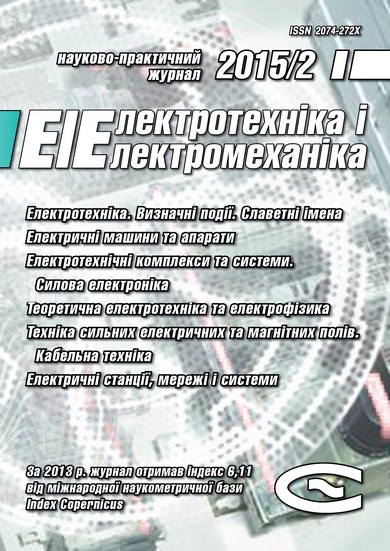SHIELDING OF A UNIFORM ALTERNATING MAGNETIC FIELD USING A CIRCULAR PASSIVE LOOP
DOI:
https://doi.org/10.20998/2074-272X.2015.2.06Keywords:
circular passive loop, electromagnetic shielding, analytical modeling, Comsol MultiphysicsAbstract
The magnetic and electromagnetic shields are used to reduce the magnetic field in local spaces. Usually these shields are implemented in the form of a box or a cylinder. At the same time the magnetic field reduction in local spaces by means of passive loops is not considered in detail yet. So, the present study considers shielding capabilities of a circular passive loop. The authors have performed an analytical and numerical modeling of a process of a uniform harmonic magnetic field shielding. The simulated results permit to find out the spatial distribution of the shielded magnetic field. Dependencies of shielding effectiveness on the passive loop radius and cross-section are determined. Moreover, the non-monotonic behavior of the loop radius dependence is shown. We have substantiated that the shielded volume of a circular passive loop is advisable to limit by the sphere with a half loop radius. Presented results give parameters of the circular passive loop that reduces the rms value of the magnetic flux density by 30 %.References
Roginskiy V.Yu. Ekranirovanie v radioustroystvah [Shielding in radio devices]. Leningrad, Energiya Publ., 1969. 112 p. (Rus).
Shapiro D.N. Elektromagnitnoe ekranirovanie [Electromagnetic shielding]. Dolgoprudny, «Intellekt» Publ. House, 2010. 120 p. (Rus).
Kaden G. Elektromagnitnyie ekrany v vyisokochastotnoy tehnike i tehnike elektrosvyazi [Electromagnetic shields in high-frequency technology and communication technology]. Moscow-Leningrad, Gosenergoizdat Publ., 1957. 327 p. (Rus).
Ziolkowski M., Gratkowski S. Active, passive and dynamic shielding of static and low frequency magnetic fields. XV International Symposium on Theoretical Engineering. VDE, 2009, pp. 1-5.
Dikoy V.P., Tokarskiy A.Yu., Rubtsova N.B, Krasin O.V. Some theoretical aspects of loop shields. Povyshenie effektivnosti raboty energosistem: Trudy IGEU – Improvement of power system efficiency: Proceedings of the Ivanovo State Power University, 2001, no.4, pp. 225-254. (Rus).
Brandão Faria J.A., Almeida M.E. Accurate calculation of magnetic-field intensity due to overhead power lines with or without mitigation loops with or without capacitor compensation. IEEE Transactions on Power Delivery, 2007, vol.22, no.2. pp. 951-959. doi:10.1109/tpwrd.2006.883025.
Lee B.Y., Myung S.H., Cho Y.G., Lee D.I., Lim Y.S., Lee S.Y. Power frequency magnetic field reduction method for residents in the vicinity of overhead transmission lines using passive loop. Journal of Electrical Engineering and Technology. 2011, vol.6, no.6, pp. 829-835. doi:10.5370/jeet.2011.6.6.829.
Kalantarov P.L., Tseytlin L.A. Raschet induktivnostey [Inductance calculations]. Leningrad, Energoatomizdat Publ., 1986. 488 p. (Rus).
Simpson J.C., Lane J.E., Immer C.D., Youngquist R.C. Simple analytic expressions for the magnetic field of a circular current loop. Preprint, NASA Kennedy Space Center Publ., 2001. 7 p.
Zhao D., Gao L. Spatial distribution of the magnetic field generated by a circular arc current. Advanced Studies in Theoretical Physics, 2010, vol.4, no.6, pp. 275-282.
Comsol Multiphysics Modeling Guide. Version: COMSOL 3.5a. November, 2008.
Downloads
Published
How to Cite
Issue
Section
License
Copyright (c) 2015 V. S. Grinchenko, K. V. Chunikhin

This work is licensed under a Creative Commons Attribution-NonCommercial 4.0 International License.
Authors who publish with this journal agree to the following terms:
1. Authors retain copyright and grant the journal right of first publication with the work simultaneously licensed under a Creative Commons Attribution License that allows others to share the work with an acknowledgement of the work's authorship and initial publication in this journal.
2. Authors are able to enter into separate, additional contractual arrangements for the non-exclusive distribution of the journal's published version of the work (e.g., post it to an institutional repository or publish it in a book), with an acknowledgement of its initial publication in this journal.
3. Authors are permitted and encouraged to post their work online (e.g., in institutional repositories or on their website) prior to and during the submission process, as it can lead to productive exchanges, as well as earlier and greater citation of published work.





